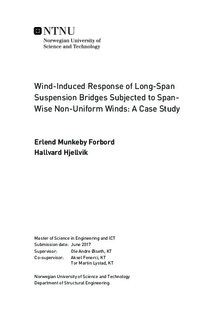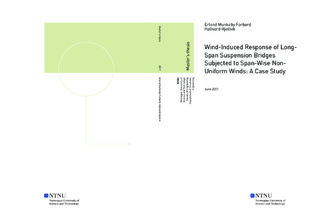| dc.description.abstract | The Hardanger Bridge has a main span of 1 310 meters which makes it the longest suspension bridge in Norway and among the top 15 longest in the world as of 2017. The bridge consists of only two traffic lanes and one pedestrian lane, which makes the bridge deck very slender. The bridge is located in a fjord in western Norway and the surroundings consist of mountains over 1 000 meters high. The mountains affect the wind field and make the wind characteristics at the bridge site span-wise non-uniform.
To verify the accuracy of dynamic response calculation methods of slender suspension bridges, a comprehensive measurement system was installed on the Hardanger Bridge after the opening in 2013. In this thesis, the main scope will be on the span-wise non-uniformity of the wind field. It will be investigated whether non-uniform wind profiles can predict the response of the bridge more accurately than uniform profiles with respect to the measured response.
A numerical study was carried out to investigate the influence of non-uniform wind speed and turbulence on the response prediction. Several profiles were studied and the concluding remarks were that the response increased for a non-uniform compared to a uniform wind speed profile. A non-uniform turbulence profile with the opposite shape of the wind profile decreased the response compared to the uniform turbulence profile. When the wind speed profile is non-uniform, the self-excited forces may also be taken as non-uniform. It was seen that for low wind speeds, the influence of including the non-uniform self-excited forces on the response was small, while for very high wind speeds the response got more unstable and the influence was larger.
The response has also been predicted using wind data from the Hardanger Bridge, and the predictions have been compared to the measured response. Uniform profiles of wind speed and turbulence have been given different values based on the measured data, more specifically the mean value of all sensors and the value from the midmost wind sensor. It is seen that the choice of value does not affect the accuracy of response predictions. No matter what values are chosen, the predictions are quite inaccurate in general. Introducing a non-uniform profile of mean wind speed makes the predictions slightly better in some cases, but not noteworthy, and the accuracy is still relatively low. When also including the non-uniformity of turbulence in the response calculations, the predicted response is reduced and the accuracy worsened with respect to the measured response. Accounting for the non-uniformity of self-excited forces shows almost no effect on the predictions. It is concluded that non-uniform wind profiles do not improve the accuracy of predicted bridge response, and that other uncertainties in the calculation methods have larger impact on the predictions than whether the non-uniform profiles are included or not. | |

